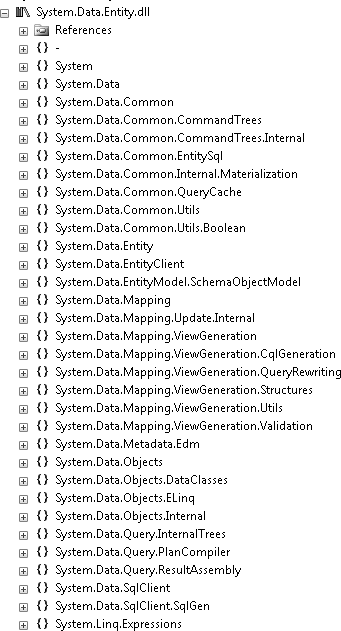This appendix will provide you with a high-level overview of the assemblies and namespaces of the Entity Framework. You will learn about the files that are used for the Entity Framework and the namespaces of the Entity Framework and their purpose.
You’ll find the physical DLL files that contain the Entity Framework APIs in the following two directories:
<system drive>:Program FilesReference AssembliesMicrosoftFrameworkv3.5, which contains:
System.Data.Entity.Design.dll
This file contains functionality related to the design tools, such as the Designer, the mapping details, and the model viewer.
System.Data.Entity.dll
This file is the root of the Entity Framework. It contains all of the namespaces and classes for programming against the Entity Data Model (EDM).
<system drive>:WindowsMicrosoft.NETFrameworkv3.5, which contains:
Microsoft.Data.Entity.Build.Tasks.dll
This file contains the functions for compilation tasks, including building the EDM schema files.
The Entity Framework lives within the System.Data namespace of the .NET Framework.
New functionality (classes, properties, and methods) has been added to
existing namespaces in the System.Data hierarchy, along with a number of
new namespaces that begin with the term
System.Data.Entity. The System.Data.Entity.dll assembly provides all
of the namespaces, as shown in Figure A-1.
A number of existing namespaces have new classes and functionality added to them to support the Entity Framework:
System.DataSystem.Datais the namespace in the .NET Framework that provides all of .NET’s data access functionality. Some functionality is contained directly inSystem.Data, and much more exists in its subnamespaces.The Entity Framework adds
Exceptionclasses directly to this namespace, as well asEntityKey, which provides a durable reference to an entity.System.Data.CommonSystem.Data.Commonprovides base classes that are common to all of the data providers written for .NET. For example,DbDataReaderis the base ofSqlDataReader,OleDbDataReader,OracleDataReader, and more. The Entity Framework adds a few high-levelDbProvidermembers into this namespace along withDataRecordInfoto expose query results in the form of aDbDataRecordandEntityRecordInfo, which provides access to the metadata of an entity.System.Data.SqlClientThe provider information that allows the ADO.NET Entity Framework to communicate with Microsoft SQL Server is added into the
System.Data.SqlClientclass through additional classes added into theSystem.Data.Entityassembly.System.Linq.ExpressionsSystem.Linq.Expressionsadds LINQ to Entities query functionality to theSystem.Linq.Expressionsnamespace.
All of the functionality that you will use directly or indirectly when working in the Entity Framework lives in the following namespaces:
System.Data.Common.CommandTreesSystem.Data.Common.CommandTreesadds logic for building Entity Framework command trees from LINQ to Entities and Entity SQL expressions. Each provider that is written to work with the Entity Framework will have the ability to turn these command trees into store queries.System.Data.EntitySystem.Data.Entitydoes not contain any classes or methods; it is the base for a hierarchy of other namespaces—namely,System.Data.Entity.DesignandSystem.Data.Entity.Design.ASP.NET(discussed shortly).System.Data.EntityClientSystem.Data.EntityClientis a standard ADO.NET managed provider supporting access to the data described in the EDM. This namespace is comparable toSystem.Data.SqlClientorSystem.Data.OracleClientand provides classes such asEntityConnection,EntityCommand, andEntityDataReader.System.Data.MappingSystem.Data.Mappingprovides logic for performing view generation from query expressions.System.Data.Metadata.EdmSystem.Data.Metadata.Edmcontains the types that are represented in the conceptual, mapping, and store schemas that define and support the EDM. Using these types directly, it is possible to programmatically work with the metadata of the model.System.Data.ObjectsSystem.Data.Objectsis the most important namespace in the Entity Framework. It provides the classes for querying, change tracking, relationship management, and updating the data store through the EDM. The functionality provided bySystem.Data.Objectand its child namespace,DataClasses, is referred to as “Object Services.”System.Data.Objects.DataClassesSystem.Data.Objects.DataClassescontains the classes and interfaces that allow types described in the EDM to be instantiated as objects. With these classes you can programmatically interact with the data that is provided as a result of querying the EDM.System.Linq.ExpressionsSystem.Linq.Expressionsadds the necessary expressions for performing LINQ to Entities queries.System.Data.Entity.DesignSystem.Data.Entity.Designprovides functionality for generating an EDM as well as performing the code generation to create classes from the EDM.System.Data.Entity.Design.ASP.NETSystem.Data.Entity.Design.ASP.NETprovides the build providers used in the build environment for ASP.NET.System.Data.Query.InternalTreesSystem.Data.Query.InternalTreesprovides the tools for converting query expressions to be converted to command trees that are executed against the Entity Framework. This is very low-level and all of the members in this namespace are sealed.System.Data.Query.PlanCompilerSystem.Data.Query.PlanCompileris another namespace filled with low-level functionality for processing queries.System.Data.QueryResultAssemblySystem.Data.QueryResultAssembly, the third subnamespace inSystem.Data.Query, is also low-level and sealed. When data is returned from the data store, it needs to be transformed into objects. This namespace contains the tools that are used internally to perform this transformation.

